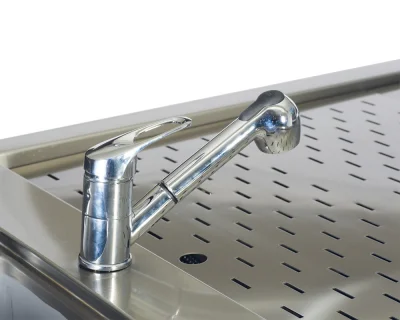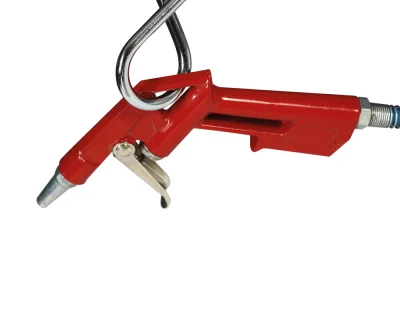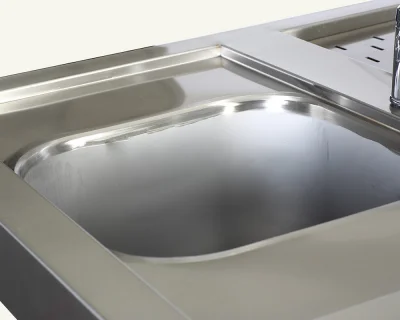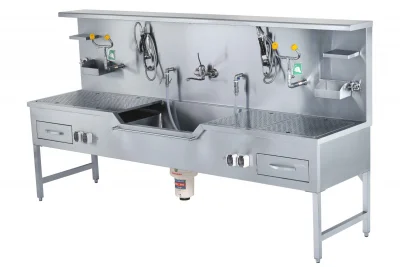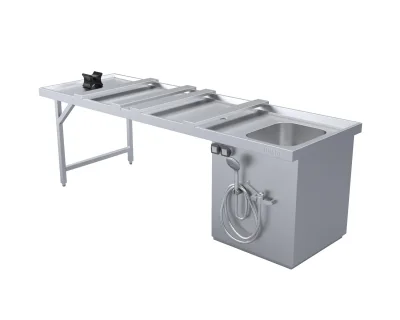Autopsy Table
- Entire inner and outer parts grade 304 stainless steel
- Shower hose with hand sprinkler
- Water/Air spray gun rinser
- Cabinet at the underside
- Dirty water outlet
- Sink and grid plates AISI 304 grade stainless steel
- Dimension (WxLxH): 900x2650x900 mm.w
An autopsy table, commonly referred to as a dissecting table, cadaver table, examination table or postmortem table, is a specialized table used for autopsies and postmortem studies. Morgue table is a necessary piece of equipment in autopsies and forensic pathology laboratories.
Mortuary tables are often made of easy-to-clean and maintain materials, such as stainless steel or other non-porous surfaces. They are intended to be hygienic, long-lasting, and stain- and corrosion-resistant.
Necropsy tables are equipped with features to facilitate the autopsy procedure, including integrated sinks, water faucets, instrument trays, waste disposal systems, and electrical outlets.
An Autopsy dissecting station's function is to provide a dedicated and sanitary platform for conducting autopsies and postmortem exams. A postmortem examination station supports the body during the examination process, aids in the containment and drainage of bodily fluids, ensure hygiene and sanitation, incorporates necessary tools and equipment, and incorporates safety features for the medical professionals involved in the autopsy procedure.
MOT 2010 is constructed with high-quality grade 304 stainless steel, ensuring durability and resistance to corrosion for both the inner and outer parts. For convenient cleaning and rinsing, MOT 2010 is equipped with a shower hose accompanied by a hand sprinkler. A water/air spray gun rinser is included in addition to the shower hose, providing versatility in cleaning methods to meet a variety of needs. MOT 2010 has an underbelly cupboard with plenty of storage space for tools and supplies and two power plugs for quick access to power sources for electronic equipment. MOT 2010 offers a comprehensive solution for conducting autopsies, providing a durable, organized, and hygienic workspace for medical professionals in their examination procedures.
Autopsy Tables: A Critical Tool for Precision and Hygiene
Autopsy tables are an indispensable piece of equipment in medical, forensic, and mortuary environments. Designed with a focus on durability, hygiene, and functionality, these tables serve as the platform for conducting detailed examinations and postmortem procedures. A well-designed autopsy table ensures the safety of the examiner, the hygiene of the environment, and the efficient handling of cadavers.
Key Features of an Autopsy Table
An autopsy table must be designed with both practicality and safety in mind. Here are some of the most critical features:
1. Durability and Build Quality:
Autopsy tables are typically constructed from high-grade stainless steel, which is both durable and resistant to corrosion. This material choice ensures that the table can withstand the rigorous cleaning and disinfection protocols required after each use. The stainless steel surface also prevents the accumulation of bacteria, ensuring that hygiene standards are maintained.
2. Integrated Drainage Systems:
Effective drainage is crucial to prevent the pooling of fluids during procedures. Most autopsy tables come equipped with a sloped surface and integrated drainage systems to efficiently manage bodily fluids. This not only helps maintain cleanliness but also ensures that the examiners can work without obstructions.
3. Adjustable Height:
For ergonomic reasons, many autopsy tables feature adjustable height mechanisms, either manually or hydraulically operated. This allows examiners to adjust the table according to their comfort, reducing strain during extended procedures. The ability to raise or lower the table is particularly helpful for accessing different parts of the cadaver more easily.
4. Ventilation and Aspiration Systems:
Many autopsy tables are equipped with ventilation systems that help to manage unpleasant odors and hazardous fumes that might arise during the procedure. These ventilation systems help maintain a safe working environment by filtering the air in real-time, reducing the risk of exposure to potentially harmful gases.
Applications of an Autopsy Table
Autopsy tables are essential in a variety of settings:
1. Forensic Laboratories:
In forensic pathology, autopsy tables are critical for performing postmortem examinations. They are used to determine the cause of death, collect forensic evidence, and conduct full-body assessments. Their high hygiene standards ensure that contamination is minimized, allowing for accurate and reliable examinations.
2. Medical Schools and Universities:
For educational purposes, autopsy tables are used to teach medical students anatomy and pathology through cadaver dissections. The durable and easily cleanable surface makes it ideal for repeated use in these settings, where maintaining sterility is essential for both educational and health reasons.
3. Mortuary Services:
In mortuaries, autopsy tables are also used for embalming, body preparation, and other procedures necessary before a burial or cremation. These tables streamline the process by offering a sanitary, easily maintained work surface that is designed for handling cadavers efficiently.
Why Choose High-Quality Autopsy Tables?
Investing in a high-quality autopsy table is essential for any facility that handles cadaver procedures. The right table not only improves the workflow but also enhances safety for staff. Stainless steel construction ensures long-lasting performance, while features like adjustable height, drainage, and ventilation systems increase functionality.
Moreover, the design of modern autopsy tables has evolved to be ergonomic, ensuring that examiners can work in a more comfortable position for extended periods. This reduces physical strain and makes the examination process smoother and more efficient.









